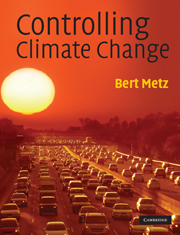Book contents
- Frontmatter
- Contents
- Preface
- 1 Climate change and its impacts: a short summary
- 2 Greenhouse gas emissions
- 3 Keeping climate change within sustainable limits: where to draw the line?
- 4 Development first
- 5 Energy Supply
- 6 Transportation
- 7 Buildings
- 8 Industry and waste management
- 9 Land use, agriculture, and forestry
- 10 How does it fit together?
- 11 Policies and measures
- 12 International climate change agreements
- Index
- Plate section
8 - Industry and waste management
Published online by Cambridge University Press: 05 June 2012
- Frontmatter
- Contents
- Preface
- 1 Climate change and its impacts: a short summary
- 2 Greenhouse gas emissions
- 3 Keeping climate change within sustainable limits: where to draw the line?
- 4 Development first
- 5 Energy Supply
- 6 Transportation
- 7 Buildings
- 8 Industry and waste management
- 9 Land use, agriculture, and forestry
- 10 How does it fit together?
- 11 Policies and measures
- 12 International climate change agreements
- Index
- Plate section
Summary
What is covered in this chapter?
Products manufactured by industry form an essential part of modern economies. Industrialization is a step in the development of countries that brings jobs and better living standards. Industrial production will therefore keep rising and will increasingly be located in developing countries. Interestingly, the most modern installations are often found in developing countries. Since industry contributes about 20% to global greenhouse gas emissions, any serious attempt to reduce global GHG emissions will have to involve industry. Using less energy intensive industrial goods like steel by making lighter cars for instance and using wood for constructing buildings instead of steel, concrete, and bricks is one way to go. Most of the emissions reduction will have to come from more efficient production (less greenhouse gas emissions per unit of product), shifting to low carbon energy sources, and using CO2 capture and storage to remove CO2 at the smokestack. For the most important processes the reduction opportunities are discussed. Government policies are needed to make these reduction opportunities a reality. Experience with various policy instruments shows that for big reductions in emissions more stringent instruments, such as cap and trade and regulations, will be needed. Voluntary agreements do initially help to raise awareness amongst participants and to encourage corporate responsibility, but delivering major emission reductions through voluntary agreements is not possible. Waste is an important emission source in industry and for household and commercial waste. There are strong interactions via recycling of paper, glass, and metals. That is why greenhouse gas emissions and waste are discussed in this chapter together.[…]
- Type
- Chapter
- Information
- Controlling Climate Change , pp. 209 - 234Publisher: Cambridge University PressPrint publication year: 2009



